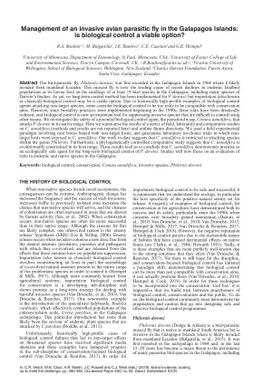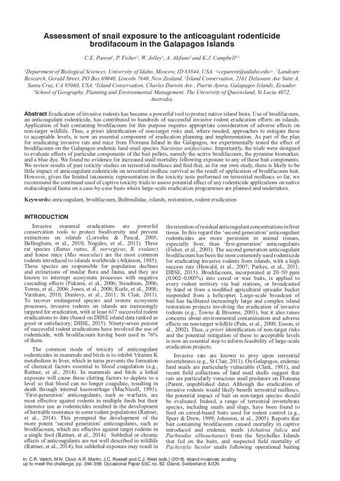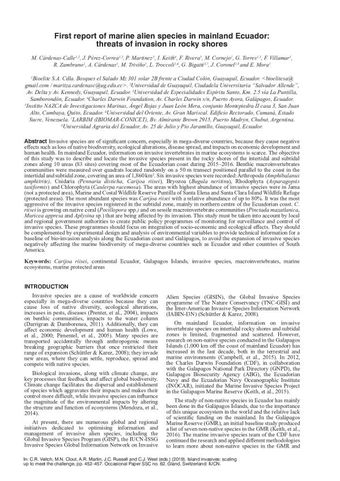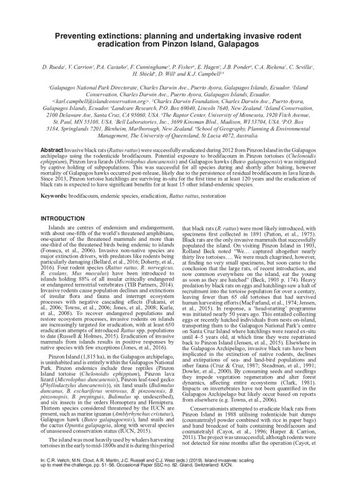Management of an invasive avian parasitic fly in the Galapagos Islands: is biological control a viable option?
- Description:
- The bird-parasitic ?y, Philornis downsi, was ?rst recorded in the Galápagos Islands in 1964 where it likely invaded from mainland Ecuador. This muscid ?y is now the leading cause of recent declines in endemic landbird populations as its larvae feed on the nestlings of at least 19 bird species in the Galápagos, including many species of Darwins ?nches. As yet, no long-term control method has been implemented for P. downsi, but importation (also known as classical) biological control may be a viable option. Due to historically high-pro?le examples of biological control agents attacking non-target species, some consider biological control to be too risky to be compatible with conservation aims. However, since biosafety practices were implemented beginning in the 1990s, these risks have been drastically reduced, and biological control is now an important tool for suppressing invasive species that are di?cult to control using other means. We investigated the safety of a potential biological control agent, the parasitoid wasp, Conura annulifera, that attacks P. downsi in its native range. Here we summarise the results of a series of ?eld, laboratory and comparative studies on C. annulifera (methods and results are not reported here) and outline future directions. We used a ?eld experimental paradigm involving nest boxes baited with non-target hosts, and quarantine laboratory no-choice trials in which non-target hosts were exposed to C. annulifera. Our work to-date suggests that C. annulifera is restricted to attacking species within the genus Philornis. Furthermore, a phylogenetically controlled comparative study suggests that C. annulifera is evolutionarily constrained in its host range. These results lead us to conclude that C. annulifera demonstrates promise as an ecologically safe agent for the long-term biological control of P. downsi. Studies will now focus on an evaluation of risks to endemic and native species in the Galápagos.
- Display date:
- 2019
- Collections:
- Secretariat of the Pacific Regional Environment Programme (SPREP)
- Publisher:
- International Union for Nature Conservation (IUCN)
- Content partner:
- Secretariat of the Pacific Regional Environment Programme (SPREP)
- Availability:
- Not specified
-
Copyright status: All rights reservedFind out more about what you are able to do with this itemThis item is all rights reserved, with means you'll have to get permission from Secretariat of the Pacific Regional Environment Programme (SPREP) before using it. For more information, please see our use and reuse page.What can I do with this item?Non-infringing useNZ copyright law does not prevent every use of a copyright work, and this item may be hosted by an international institute or organisation. You should consider what you can and cannot do with a copyright work.No sharingYou may not copy and/or share this item with others without further permission. This includes posting it on your blog, using it in a presentation, or any other public use.No modifyingYou are not allowed to adapt or remix this item into any other works.No commercial useYou may not use this item commercially.
Related items
Welcome and warm Pasifik greetings
The information on this site has been gathered from our content partners.
The names, terms, and labels that we present on the site may contain images or voices of deceased persons and may also reflect the bias, norms, and perspective of the period of time in which they were created. We accept that these may not be appropriate today.
If you have any concerns or questions about an item, please contact us.



